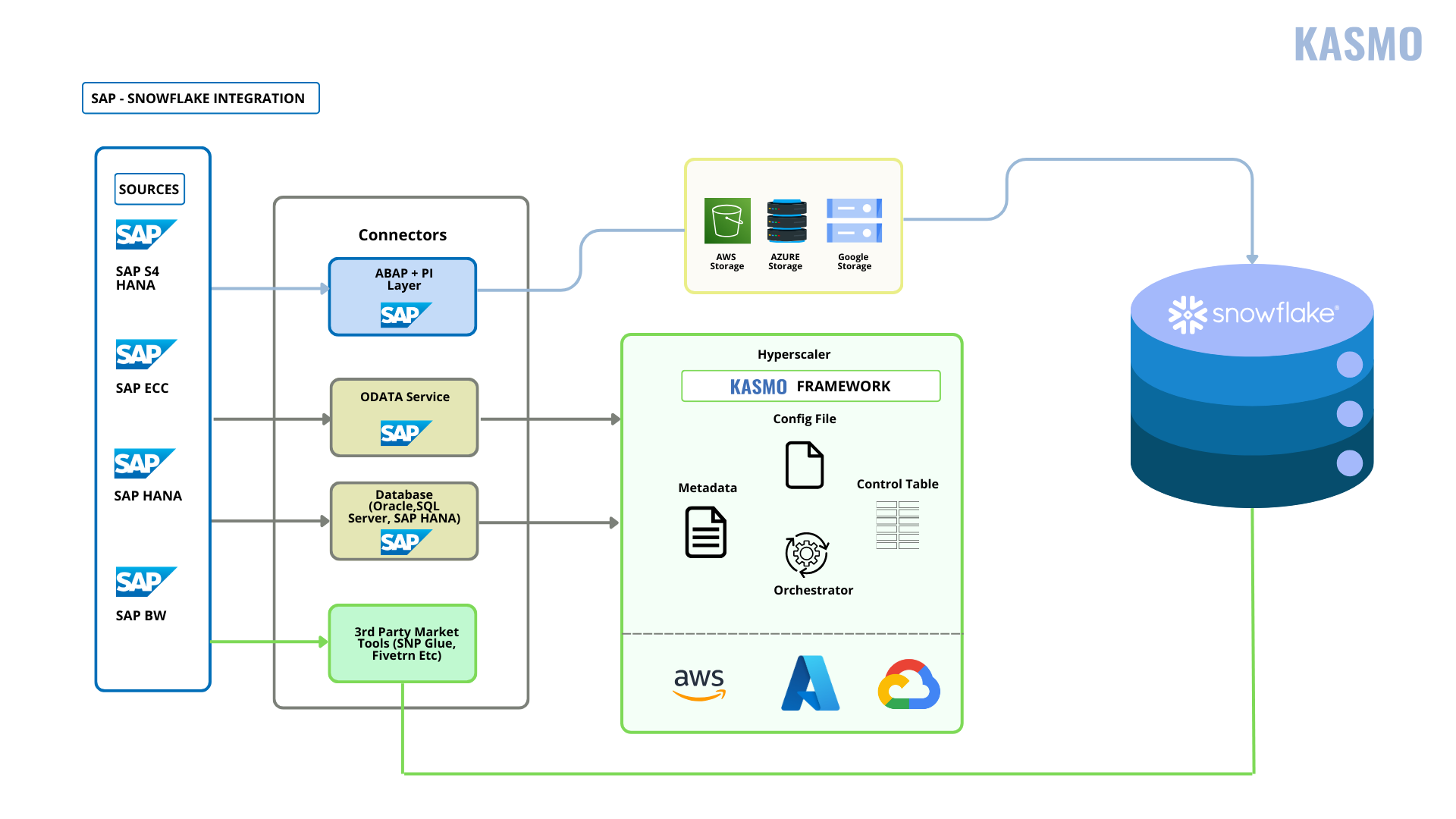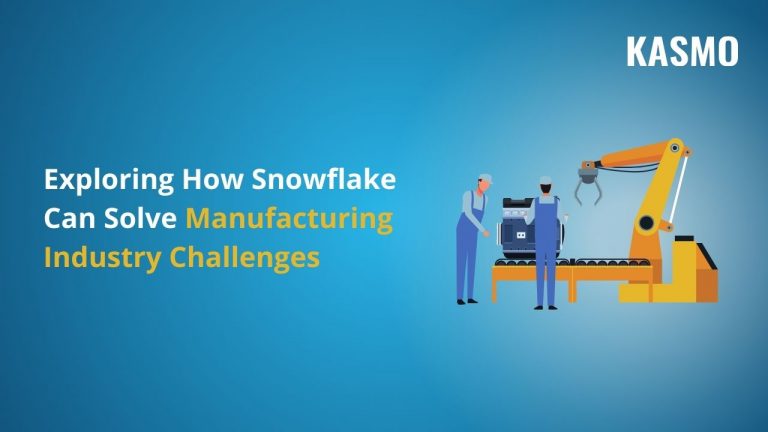There are a lot of benefits that manufacturers can achieve from advanced analytics. However, there are still many businesses that are implementing legacy architectures to store their data and then trying to draw analysis from them. To tackle the modern-day manufacturing industry challenges, business leaders are looking for scalable architectures that can not only store increasing amounts of data but also perform analysis.
SAP has been one of the most popular choices among manufacturing companies to store their ERP data and analyze it. But the real challenge arises when businesses try to use it to perform analytics in SAP. SAP data platforms are expensive, complex, and difficult to use.
It also lacks a flexible data-cloud model that is crucial for the manufacturing industry. With a lack of a consolidated resource planning system, they often face more challenges such as siloed data that makes it impossible for manufacturing companies to get enterprise-wide visibility. Moreover, it is also difficult to integrate non-SAP data which leads to a cost-intensive and expensive process.
If you are using SAP for manufacturing, then you might find that its architecture can create a roadblock while you are trying to analyze your ERP. With its multiple tables, it becomes difficult to understand each table and column. On top of this, SAP also uses clustered tables and calculated views that most users find difficult to understand. Additionally, it also has multiple interconnected components and modules that make it difficult for users to implement changes as required.
So, what’s the solution?
Reasons Why You Need to Migrate Your ERP Data from SAP To Snowflake
Let’s look at some of the main reasons why you need to migrate your ERP data from SAP to Snowflake:
Robust and Flexible Data Architecture
Snowflake’s robust and flexible data architecture can facilitate any amount of data volume, velocity, and variety. It reduces downtime and manufacturers do not need to incur any additional cost to upgrade or compute any changes in the architecture. As ERP systems harbor all different types of data, Snowflake is the best choice for manufacturers to deal with SAP challenges.
This platform has a single data repository that supports all different kinds of data, including external or third-party data. It also allows manufacturers to gain enterprise-wide visibility which was not possible in SAP. Snowflake is flexible, which makes it easy to shift it from different platforms without the need for separate data migration every time. Once your ERP data is on Snowflake, you can easily scale your data across the three major cloud platforms – AWS, Azure, and GCP. You don’t need to switch providers and the best part of this data-sharing capability of Snowflake – no operational issue.
Easy to Use
The simplicity of Snowflake’s architecture enhances the user experience. As a fully self-managed system, it automatically handles storage capacity, compression, statistics, and performance. Built-in automation removes the need for manufacturers to create indexes or invest any capital for maintaining the framework frequently.
Snowflake’s easy, natural language and low code data framework removes the need for companies to invest in experts who can use programming languages to generate queries. Queries can be generated in natural language within familiar programming constructs. You don’t need to learn a new programming language or collect extra tools to analyze your ERP data. Use already available tools that you have and yield results in less time. Spend less time training the AI/ML models in Snowflake.
Elasticity
With Snowflake’s scalable architecture manufacturers can choose services as per their business requirements. This data cloud platform also allows manufacturers to scale their data independently and elastically in a matter of seconds.
Kasmo’s client, a global MarTech company reduced their downtime to almost 80% by implementing the Snowflake data architecture. Our experts also helped this client to easily migrate their data and enable data sharing with other Snowflake as well as non-Snowflake accounts.
Read how Kasmo’s expertise can help you reduce downtime and scale huge amounts of data with Snowflake. Read the success story.
Easy Data Sharing
The complex architecture of SAP HANA does not allow manufacturers to share data and gain a comprehensive overview of their processes and organization. However, the data-sharing capabilities of Snowflake allow them to integrate both their IT and OT data. This allows manufacturers to gain better visibility, collect real-time data, enhance ERP data analysis, and achieve a complete and accurate overview of customer profiles. To solve supply chain challenges in the manufacturing industry, complete visibility is crucial. The Snowflake ecosystem also allows the manufacturers to add their third-party datasets through the Snowflake marketplace enhances data analysis and provides near-real-time insights.
Data Security
Snowflake’s sophisticated cloud security feature allows manufacturing companies to adhere to data security and privacy policies. With features like Dynamic Data Masking, it adds an extra layer of security for any sensitive data. In Snowflake, you will also have autonomous control over your data. You can choose how much data you wish to share, and with whom to share. You don’t need to change your ERP environment. Moving your ERP data from SAP to Snowflake will offload your challenges.
What are the Benefits of Moving Your ERP Data from SAP to Snowflake?
Apart from the above points that explain the necessity of moving your ERP data from SAP to Snowflake, here are some more benefits of ERP migration:
Utilize AI and Machine Learning Capabilities
When you migrate your ERP data to Snowflake, you can seamlessly integrate it with other non-ERP data from various other sources also stored in Snowflake. This creates a single source of truth for all essential business data, enabling manufacturers to gain a more comprehensive analysis. This also helps you get richer insights that go beyond what ERP data analysis on SAP would have provided you. With your data centralized in Snowflake, your organization gains access to a wide array of AI tools, including Snowpark, which plays a key role in enhancing your data capabilities.
Leverage the Advanced Analytics of Snowflake
Snowflake’s seamless integration with popular business intelligence (BI) and analytics tools empowers data analysts and scientists in your organization to access and analyze ERP data effortlessly. It uses familiar interfaces and workflows and centralizes ERP data that can derive deeper insights into critical business metrics, trends, and performance indicators. This centralized approach fosters more informed decision-making, strategic planning, and operational optimization.
Moreover, utilizing a modern data stack also significantly shortens the time required to gain accurate and data-driven insights. The analysts of your organization do not have to deal with SAP’s complex data modeling to derive performance analysis from ERP data. This AI data cloud platform also reduces the dependency on specialized tools, enabling a more self-service analytics environment. Snowflake streamlines the analytics process and democratizes data access across the organization, empowering manufacturers to engage with ERP data and drive insights.
Incur Low Cost
Snowflake’s flexible compute and storage scaling capabilities enable manufacturers to better manage costs when compared to costs incurred in SAP alone. Organizations can also reduce the number of analytics licenses required for SAP, significantly lowering the total cost of ownership (TCO) for data management. Now conduct analytics within Snowflake without any hassle.
Democratize Your Data
Snowflake eliminates data silos, allowing manufacturers to have more accessibility of their data. It centralizes SAP ERP data, which helps a diverse range of users across different departments to gain access to their data. Snowflake promotes unrestricted data exploration without the need to gain extra and complex licenses. This democratization of data enables more users to independently access and derive insights, strengthening efficiency, productivity and optimizing data-driven decisions.
Why Choose Kasmo for Tackling the Manufacturing Industry Challenges?
The Snowflake experts at Kasmo have created accelerators that help you tackle complex manufacturing industry challenges and analyze your ERP data. Let’s find out more about these accelerators:
- The data load solution accelerator of Kasmo is a low-cost, simplified, and low-code ELT/ETL framework. With this framework, our team of experts spends less time creating and configuring ETL/ELT jobs with minimal code required. This will help you achieve faster results, high scalability, flexibility, and security for data integration projects.
- The SAP to Snowflake Migration accelerator is a cost-effective, low-code solution that streamlines data migration from SAP to Snowflake. It uses a simplified ELT/ETL framework, enabling the creation of a quicker and minimal-code pipeline. This framework enhances scalability, flexibility, and security for efficient and secure data integration.
Here’s a diagram to help you understand how Kasmo helps in SAP ERP Data Integration:

Conclusion
Migrating your ERP data from SAP to Snowflake can help you tackle several manufacturing industry challenges at once. By leveraging Snowflake’s robust and flexible architecture, you can eliminate data silos, enhance accessibility, and foster collaboration across departments. This facilitates comprehensive analysis and better decision-making. Snowflake also helps you reduce costs, and drive operational optimization and strategic planning.
By choosing to partner with us, you can streamline the ERP migration process and maximize the benefits of your ERP data. Leveraging Snowflake helps you overcome the limitations of legacy systems and stay relevant in this competitive market.


